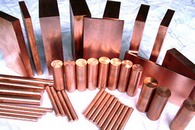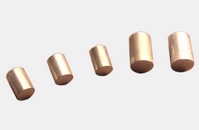Copper tungsten electrode



What's electrodes?
An electrode is an electrical conductor used to make contact with a nonmetallic part of a circuit (e.g. a semiconductor, an electrolyte or a vacuum). The word was coined by the scientist Michael Faraday from the Greek words electron (meaning amber, from which the word electricity is derived) and hoods, a way.
Copper tungsten is a good use of high-purity tungsten metal powder and high purity characteristics of the plasticity of copper powder, the advantages of high conductivity, the static pressure molding, high temperature sintering, melting refined copper from the process of composite materials. Arc off a good performance, good thermal conductivity, thermal expansion of small, high-temperature non-softening, high-intensity, high-density, high hardness.
Resistance welding electrode
A combination of the advantages of tungsten and copper, high temperature resistance, electric arc ablation, high intensity, than the major, conductive, thermal conductivity, and ease of machining, and it has features such as cold sweating, as with tungsten high hardness, high melting point, anti-adhesion characteristics, often used to do a certain resistance to abrasion, resistant to high temperature welding, butt welding electrode.
EDM electrode
In view of tungsten steel, high temperature super-hard alloy die to be produced by corrosion, the common electrode wear big, slow, and the copper tungsten electrical corrosion of high speed, low loss rate, precise electrode shape, excellent processing performance, to ensure the accuracy of processing pieces of greatly increased.
High-voltage electrode discharge tube
High-voltage vacuum discharge tube in the workplace, the contact material in a few seconds of time zero temperatures thousands of degrees Celsius, while the copper tungsten anti-ablation properties, high toughness, good electrical conductivity, thermal conductivity performance to the discharge tube to provide the necessary stability conditions.
Electronic packaging materials
Both the low-expansion properties of tungsten, but also has high thermal conductivity properties of copper, its thermal expansion coefficient and thermal conductivity of conductive material can be adjusted to change the composition and thereby to the material provided to facilitate the use.
Copper tungsten data sheet
|
Grade |
Cu%(WT) |
W%(WT) |
RWMA |
Density |
Electric Conductivity |
Hardness (Min) |
| CuW55 | 45±2 | Balance | 10 | 12.30g/cm3 | 55%IACS | 125HB |
| CuW60 | 40±2 | Balance | 12.75g/cm3 | 52%IACS | 140HB | |
| CuW65 | 35±2 | Balance | 13.30g/cm3 | 50%IACS | 155HB | |
| CuW70 | 30±2 | Balance | 13.80g/cm3 | 49%IACS | 175HB | |
| CuW75 | 25±2 | Balance | 11 | 14.50g/cm3 | 47%IACS | 195HB |
| CuW80 | 20±2 | Balance | 12 | 15.15g/cm3 | 42%IACS | 220HB |
| CuW85 | 15±2 | Balance | 15.90g/cm3 | 35%IACS | 240HB |
Related Links
Silver Tungsten Electrode
Material Safety Data Sheet of Copper Tungsten
Material Safety Data Sheet of Copper Tungsten (PDF)
Property Data Sheet of Copper Tungsten Material (PDF)
Address : 3F,No.25 WH Rd,the 2nd Xiamen Software Park,FJ,China 361008
Email : chinatengsten@gmail.com
Copyright©2001 - 2011 CTIA E-biz Center All Rights Reserved















